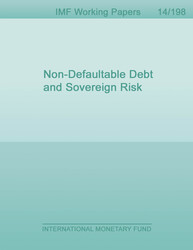
Non-Defaultable Debt and Sovereign Risk
We quantify gains from introducing non-defaultable debt as a limited additional financing option into amodel of equilibrium sovereign risk. We find that, for an initial (defaultable) sovereign debt level equalto 66 percent of trend aggregate income and a sovereign spread of 2.9 percent, introducing the possibilityof issuing non-defaultable debt for up to 10 percent of aggregate income reduces immediately the spreadto 1.4 percent, and implies a welfare gain equivalent to a permanent consumption increase of 0.9 percent.The spread reduction would be only 0.1 (0.2) percentage points higher if the government uses nondefaultabledebt to buy back (finance a "voluntary" debt exchange for) previously issued defaultabledebt. Without restrictions to defaultable debt issuances in the future, the spread reduction achieved by theintroduction of non-defaultable debt is short lived. We also show that allowing governments in default toincrease non-defaultable debt is damaging at the time non-defaultable debt is introduced andinconsequential in the medium term. These findings shed light on different aspects of proposals tointroduce common euro-area sovereign bonds that could be virtually non-defaultable.
Publication date: October 2014
ISBN: 9781498325189
$18.00
Add to Cart by clicking price of the language and format you'd like to purchase
Available Languages and Formats
| English |
Prices in red indicate formats that are not yet available but are forthcoming.
Topics covered in this book
This title contains information about the following subjects.
Click on a subject if you would like to see other titles with the same subjects.
Economics- Macroeconomics , Economics / General , International - Economics , sovereign default , sovereign debt , Eurobonds , red bonds , blue bonds , buyback , voluntary debt exchange
Summary
Copyright © 2010 - 2024
Powered by:
AIDC



